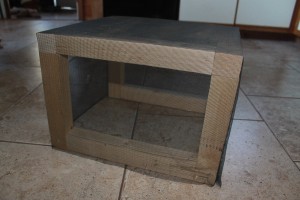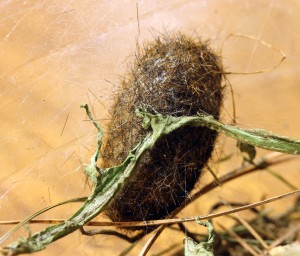Just about everyone knows what a Woolly Bear Caterpillar, Pyrrharctia isabella looks like but very few know the later stages of the Woolly Bears life. Over the next several months you can join us here at MyNatureApps.com as we follow Wizard our captive Woolly Bear Caterpillar.  We’ll be watching Wizard as he makes his change from a caterpillar into an Isabella Tiger Moth.
We’ll be watching Wizard as he makes his change from a caterpillar into an Isabella Tiger Moth.
If you find a Woolly Bear and bring him in the house STOP and read this first before you do anything else! click here
If you would like to watch the transformation from caterpillar into moth first hand the first thing you’ll need to do is find a Woolly Bear. Fortunately that’s the easy part. Woolly bears are easily found in the fall months seeking out shelter to hibernate in or under. Look outside under lawn furniture, leaves, logs and rocks, your sure to find one.
Keeping a Woolly Bear captive for observation is fairly easy. You only need to gather a few things first.
- The first you’ll need is a container which can be as simple as a plastic cup to the something the size of a small aquarium. We are using a clear plastic pot liner.
- Cover the bottom of the container with a little soil. Use soil from the area you found the caterpillar in. Place from 1/2 inch to 1 inch of soil in the bottom of your container.
- Collect some grass and line the top of the soil with it.
- Gather leaves from the area you found the Woolly Bear in. Woolly Bears use leaves for food, you’ll want to gather a variety of the leaves in the immediate area. Place 2 to 3 leaves in the container.
- Put extra leaves in a plastic bag and place them in the refrigerator. Use these leaves to replace the leaves in the container as needed.
- Place a few sticks inside the container for the Woolly Bear to climb on and to hide under as well.
- Place a lid over the container with holes poked through so the Woolly Bear can get air but not escape.
- Using a spray bottle mist the sides of the container and the surface of the leaves every three days. A few sprays is all you’ll need.
- Place the container with your Woolly Bear outside somewhere safe where you can check on him regularly. You won’t need to worry about fresh leaves and misting the surface once the weather is near or below freezing your Woolly Bear will be hibernating at this time.
Woolly Bears nearly freeze solid during hibernation. Their body produces a chemical called a cryoprotectant that acts like an anti freeze which protects their organs and body tissues from being damaged from freezing. Once spring arrives and the outdoor temperatures begin to warm to the high 40’s and 50’s the caterpillar thaws out and becomes active again. You’ll have to supply it with fresh food again at this point. Find some green leaves, dandelion leaves are great and are some of the first green leaves to show up in the Spring.
The Woolly Bear will soon spin a cocoon and pupate eventually emerging as an adult Tiger Moth. When the caterpillar emerges as an adult it will have a short life span where it will need to find a mate and lay it’s eggs to complete the life cycle. The adult moth will only live for one to two weeks. They have no mouth parts so they essentially starve to death.
Once the Woolly Bear has made its cocoon you’ll want to place a the whole container with the top removed in a screened in area, this way you will be able to view the Tiger Moth without disturbing it. You can fabricate a small screen enclosure out of old screen windows or just pick up a few feet at the local hardware store. You don’t need a huge screened area, a small roughly built 12 inch by 12 inch cage is plenty big enough.
After the Tiger Moth has emerged and you have been able to view him for a little while it’s important that you set him free so he can find a mate and fulfill the purpose of his life. Simply bring the whole enclosure outside and remove the top and he’ll eventually fly away. Once he finally takes off give yourself a big pat on the back because over the past several months you witnessed one of the true miracles of Nature. Enjoy!!
A little later in the year we’ll do an update on Wizard to let you know how he’s progressing and we’ll do a little folklore on the Woolly Bear.
3~31~13 Update
Ahhhhh….. Spring has finally decided to stop in for a visit, I certainly hope it stays. Yesterday was the first big melt and we still have about 2 feet of snow left to disappear. After 6 months of winter it can’t go away soon enough for me. The warm air jarred my memory that Wizard would be waking up soon from his deep sleep. A quick check in the shed and I found him nestled down in the soil under a maple leaf in the enclosure we made him last Fall.  I spent about 3 minutes yesterday making a new enclosure so we can witness the final miracle in Wizards life.
I spent about 3 minutes yesterday making a new enclosure so we can witness the final miracle in Wizards life.
Nothing special really just some 2×2’s naiiled up to make a frame to hold some screen in place. Once Wizard completes his morph into a Tiger Moth we’ll snap a couple pictures and set him free to find a mate and complete his lifes mission.
4~16~13
A quick check on Wizard this evening revealed that he had spun his cocoon and was partially attached to the side of the container and a wilted dandelion leaf. We had been placing fresh leaves in his enclosure everyday in case he decided to have a healthy snack. The last I looked in on him was the night of the 14th and he was still moving around. That means that  sometime between the night of the 14th and this afternoon which is the 16th Wizard moved closer to the last stage of his life. The image on the right is a perfect example of what a Woolly Bears cocoon looks like. If you look closely you’ll notice they even use their own hair to make their cocoon.
sometime between the night of the 14th and this afternoon which is the 16th Wizard moved closer to the last stage of his life. The image on the right is a perfect example of what a Woolly Bears cocoon looks like. If you look closely you’ll notice they even use their own hair to make their cocoon.
Wizard should be emerging from his cocoon sometime between 10 to 15 days from now. I can’t wait to see him morphed into his new body and eventually fly away.
Stay tuned there’s definitely more to come!
Read the following before attempting to raise a Woolly Bear
Do Not try to keep a Woolly Bear caterpillar in your house because you think it’s to cold out. Your disrupting Nature and interfering with the natural life cycle of the caterpillar. Woolly Bears are designed to withstand the coldest winter. They produce their own antifreeze and nothing will happen to them if left outdoors. You may have good intentions but you are NOT HELPING the caterpillar at all and in fact you may be KILLING IT!
If you plan on capturing and keeping a Woolly Bear captive for the winter then follow these suggestions.
- Place the caterpillar in a container with twigs, soil and leaves (dried leaves to hide under)
- Place the container outdoors, NOT inside your house. Place it somewhere safe like inside a shed or screened porch. Keep it out of the direct sunlight so it does not warm up and prematurely arouse the hibernating caterpillar.
- If the caterpillar is still active you MUST supply it with fresh green leaves daily to eat. Dandelion leaves are fine as are clover and fresh grass. Replace the leaves daily until the caterpillar hibernates. Once it awakens in the Spring you must supply fresh food again on a daily basis until it spins its cocoon.
- Misting the container occasionally stops it from becoming to dry. Think of what happens outdoors. It rains, it snows, it’s humid. An occasional mist while it hibernates will not hurt it. Just do not saturate the container in water.
- Woolly Bears are most active and night and sleep during the day. It doesn’t mean it’s dead if it doesn’t move.
- Once it spins its cocoon it may take from 1 to 3 weeks to emerge as a Tiger Moth.
- Some Woolly Bears may spin their cocoon and remain inside that over the winter.
- Remove any droppings that start to build up in the container while the caterpillar is active.
- You must let the adult moth go free outdoors to complete its life cycle. It will find a mate, lay eggs and die.
And finally worth repeating, Do not keep a Woolly Bear you found in the Fall inside your house because you think your helping it from the cold, you’re not! It belongs outdoors where it’s cold. These creatures have survived millions of years without your warm house to save them. It’s a good practice to observe Nature but not interfere with it.














What Others Have to Say